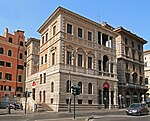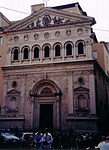Santissime Stimmate di San Francesco
1714 establishments in Italy1714 establishments in the Papal States18th-century Roman Catholic church buildings in ItalyBaroque architecture in RomeChurches of Rome (rione Pigna) ... and 2 more
Roman Catholic churches completed in 1714Roman Catholic churches in Rome

The Ss. Stimmate di San Francesco ("Church of the Holy Stigmata of St. Francis") is a church in central Rome, Italy, in the Rione Pigna, sited where previously there was a church called Ss. Quaranta Martiri de Calcarario. It is located on via dei Cestari, near the corner with Corso Vittorio Emanuele II and across the street and diagonal from the Largo di Torre Argentina. The first church in this location was consecrated in 1297. In 1597, the land was given by Pope Clement VIII to the Confraternita delle Ss.Stimmate; the construction of a new building was completed in 1714, from designs by Giovanni Battista Contini.
Excerpt from the Wikipedia article Santissime Stimmate di San Francesco (License: CC BY-SA 3.0, Authors, Images).Santissime Stimmate di San Francesco
Largo delle Stimmate, Rome Municipio Roma I
Geographical coordinates (GPS) Address External links Nearby Places Show on map
Geographical coordinates (GPS)
| Latitude | Longitude |
|---|---|
| N 41.896388888889 ° | E 12.477777777778 ° |
Address
Santissime Stimmate di San Francesco
Largo delle Stimmate
00186 Rome, Municipio Roma I
Lazio, Italy
Open on Google Maps










